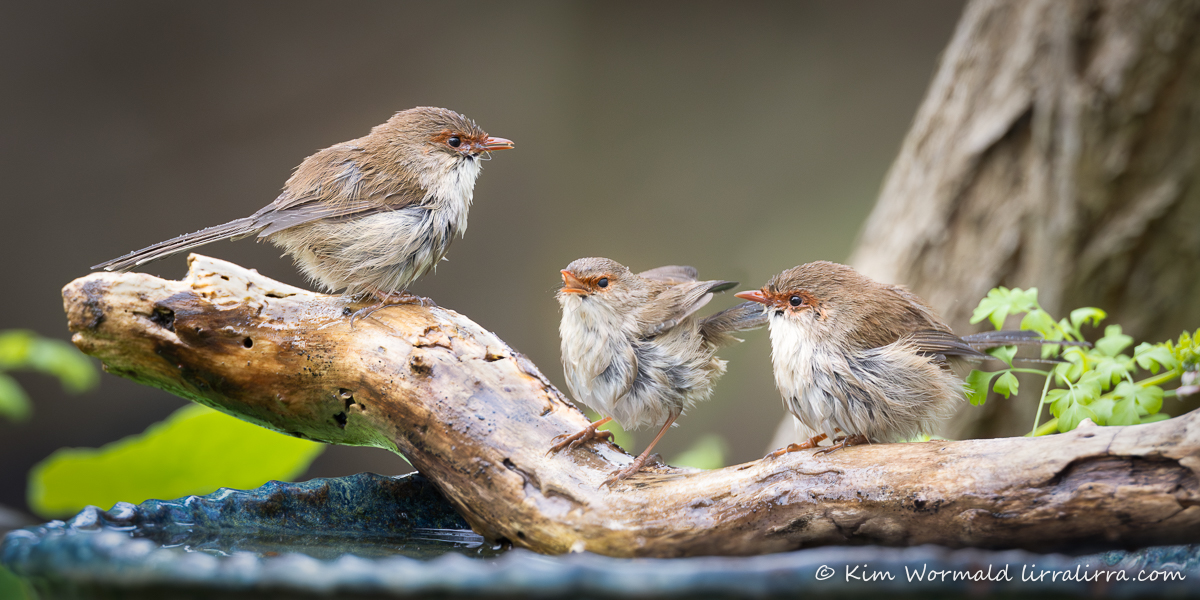I love watching Superb Fairywren families as they do their regular circuit around my property.

I’ve recently raised this gorgeous handmade (thank you Fiona) birdbath onto a stand between two other birdbaths and it has become a favourite spot for the fairywrens to bathe.
Although juvenile fairywrens have brown lores and bills they don’t have the bluish tinge to their tails that these three have. Also, the local juvenile males have bills that are already turning black. This year there is even one stately male that has retained his bright blue breeding plumage over winter. He is the dominant male in the family group, even though most of the offspring he helps raise won’t be genetically related to him. I’ve written before about the promiscuous behaviour of female fairywrens sneaking off for pre-dawn liaisons with neighbouring males. They have a fascinating social structure.
There is something magical about fairywrens. Even though I’m likely to see them several times each day I always pause to watch them and am always thrilled to see their antics. I hope they make you feel just as content.
Happy birding, Kim
~ Prints and gifts Lirralirra Shop
~ Facebook page Kim Wormald – lirralirra
~ Facebook group Ethical Bird Photography

Beautiful! I wonder if these ladies are getting together for a gossip about their scandalous extramarital affairs…
Now there’s an interesting thought. But the flip side must be the ladies that visit the male while the wife is away… if you follow my drift!
Fairy wrens are very beautiful. Unfortunately, we don’t get any where I live.
I hope you get to see them on walks Duck-Lovin’ Kid, they really are little beauties
Charming photo, Kim – thank you. I must admit to being rather obsessed with fairy wrens! I love their dinky little tails, and the males’ brilliant turquoise plumage. They are a joy to sketch. I can always hear them when I’m riding past the clumps of saltbush down by the bay – they make that ‘Tsip tsip tsip’ soft alarm call whenever they feel even slightly threatened. I have noticed, sadly, a decline in their large numbers lately, and a visiting bird expert, who gave a talk at our library, told me that the native noisy miners are to blame -they are extremely aggressive and territorial birds, and they bully small birds and drive them out of their territory. Noisy miners seem to be thriving, and even though they are native, I really can’t stand the buggers! Fairy wrens are gutsy little birds, but they are so delicate, you can see why they would be easily bullied. I’ll never forget, on my birthday a couple of years ago, I sat down on the lawn by the bay for a rest from cycling, and sat there treating myself to a piece of birthday cake, when suddenly a brilliant blue fairy wren hopped out of the saltbush, and skipped and hopped and danced in front of me for about 10 minutes! I could have reached out and touched him, he was so close to my feet. No cake for him, being a keen insectivore, but I wished I had a packet of meal worms in my pocket to give him a little treat, too. That was a magical moment, and the best birthday prezzie ever! He made my weary heart sing!
Oh Deirdre what an absolutely beautiful little blessing on your birthday – moments like that are so magical and memorable.
I agree about the Noisy Miners. From my reading part of their increase in numbers is due to people planting nectar-rich plants, which might seem like the right thing to do but apparently is favoured by the noisies who then terrorise the other honeyeaters and bush birds. It’s interesting that people are so hard on the Common Mynas (understandably) when the native Noisy Miners are more disruptive.
I have a soft spot for fairywrens too, and love seeing and hearing them at every opportunity.
Absolute enchantment. And joy.
Megathanks.
I haven’t seen them yet this morning, hopefully they will wander by, soon.